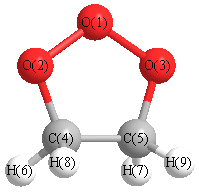Vibrational Frequencies calculated at CCSD(T)/cc-pVDZ
| Mode Number |
Symmetry |
Frequency
(cm-1) |
Scaled Frequency
(cm-1) |
IR Intensities
(km mol-1) |
Raman Act
(Å4/u) |
Dep P |
Dep U |
|---|
| 1 |
A' |
3152 |
3085 |
|
|
|
|
| 2 |
A' |
3069 |
3004 |
|
|
|
|
| 3 |
A' |
1506 |
1474 |
|
|
|
|
| 4 |
A' |
1340 |
1312 |
|
|
|
|
| 5 |
A' |
1237 |
1211 |
|
|
|
|
| 6 |
A' |
1023 |
1002 |
|
|
|
|
| 7 |
A' |
946 |
926 |
|
|
|
|
| 8 |
A' |
858 |
840 |
|
|
|
|
| 9 |
A' |
838 |
821 |
|
|
|
|
| 10 |
A' |
691 |
677 |
|
|
|
|
| 11 |
A' |
406 |
397 |
|
|
|
|
| 12 |
A" |
3135 |
3069 |
|
|
|
|
| 13 |
A" |
3056 |
2991 |
|
|
|
|
| 14 |
A" |
1489 |
1457 |
|
|
|
|
| 15 |
A" |
1339 |
1311 |
|
|
|
|
| 16 |
A" |
1214 |
1189 |
|
|
|
|
| 17 |
A" |
1151 |
1126 |
|
|
|
|
| 18 |
A" |
1035 |
1013 |
|
|
|
|
| 19 |
A" |
742 |
726 |
|
|
|
|
| 20 |
A" |
645 |
631 |
|
|
|
|
| 21 |
A" |
120 |
117 |
|
|
|
|
Unscaled Zero Point Vibrational Energy (zpe) 14495.6 cm
-1
Scaled (by 0.9788) Zero Point Vibrational Energy (zpe) 14188.3 cm
-1
See section
III.C.1 List or set vibrational scaling factors
to change the scale factors used here.
See section
III.C.2
Calculate a vibrational scaling factor for a given set of molecules
to determine the least squares best scaling factor.
